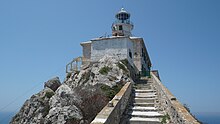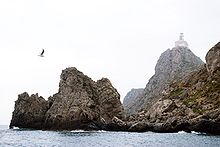Palagruža
 | |
 | |
| Location | Palagruža Island,Croatia |
|---|---|
| Coordinates | 42°23′34″N16°15′32″E/ 42.392863°N 16.258828°E |
| Tower | |
| Constructed | 1875 |
| Construction | stone tower |
| Height | 23 metres (75 ft) |
| Shape | cylindrical tower with balcony and lantern rising at the center of 2-story keeper's house[1] |
| Markings | unpainted tower, white lantern |
| Power source | solar power |
| Light | |
| Focal height | 110 metres (360 ft) |
| Range | main: 26 nautical miles (48 km; 30 mi) reserve: 12 nautical miles (22 km; 14 mi) |
| Characteristic | Fl W 17.5s. |

Palagruža(pronounced[palǎɡruːʒa];[2]Italian:Pelagosa) is a smallCroatianarchipelago in the middle of theAdriatic Sea.It is uninhabited, except by lighthouse staff and occasional summer tourists. Palagruža can be reached only by a chartered motorboat, requiring a journey of several hours from nearby islands like Lastovo,Korčula,orVis.It is administratively part of the municipality ofKomiža.
Etymology
[edit]The place is known in Italian asPelagosa,derived fromAncient GreekPelagousae(Πελαγούσαι,'sea'). This is the source of the current Croatian name, as well as of the name ofpelagosite.Gružalso means 'ballast' in Croatian, and the term is therefore well known in two ways to seafarers. The islands are also associated with the Greek mythologyDiomediaorIslands of Diomedes.
Lighthouse
[edit]On the highest point of the main island is a lighthouse.[3]Palagruža is surrounded by dangerous waters, and landing can be difficult. It is uninhabited, except by lighthouse staff and by summer tourists who occupy two units of residentialaccommodation.[4]There is one beach of golden sand. The lighthouse is also the site of a meteorological station. Other important islands in this archipelago are Mala Palagruža (Italian:Pelagosa Piccola), Galijula (Italian:Caiola) and Kamik od Tramuntane (Italian:Sasso di Tramontana)
Geography
[edit]Palagruža consists of one larger island, calledVelaorVelika('Great') Palagruža, and a smaller one,Mala('Little') Palagruža, as well as a dozen nearby rocks and reefs composed ofdolomite.All the main islets are in the form of steep ridges. Vela Palagruža is some 1,400 metres (4,600 feet) long and 330 metres (1,080 feet) wide.[5]The highest point of thearchipelago,on Vela Palagruža (Italian:Pelagosa Grande), is about 90 metres (300 feet)above sea level.
The archipelago is 123 km (76 mi; 66 nmi) south ofSpliton the Croatian mainland, 60 km (37 mi; 32 nmi) south-west ofLastovo,Croatia, and 53 km (33 mi; 29 nmi) north-north-east of theGarganopeninsula in Italy. It is visible from land only from other remote islands of Italy and Croatia. Palagruža is further south than the mainland peninsula ofPrevlaka,making it the southernmost point of Croatia.[6]
Geology
[edit]Velika Palagruža is an apical part of subsurface geological complex, composed of carbonate, siliciclastic and evaporite rocks of different ages, ranging from Triassic (c. 220 milllion years ago), through the Miocene (c. 10 million years ago), to Quaternary (recent deposition).[7]
Climate
[edit]| Palagruza(Palagruža, Croatia) | ||||||||||||||||||||||||||||||||||||||||||||||||||||||||||||
|---|---|---|---|---|---|---|---|---|---|---|---|---|---|---|---|---|---|---|---|---|---|---|---|---|---|---|---|---|---|---|---|---|---|---|---|---|---|---|---|---|---|---|---|---|---|---|---|---|---|---|---|---|---|---|---|---|---|---|---|---|
| Climate chart (explanation) | ||||||||||||||||||||||||||||||||||||||||||||||||||||||||||||
| ||||||||||||||||||||||||||||||||||||||||||||||||||||||||||||
| ||||||||||||||||||||||||||||||||||||||||||||||||||||||||||||
Palagruža has a weather station, established in 1894, which represents a major indicator of weather, especially wind, waves and precipitation on the open Adriatic. Weather conditions on the central Adriatic are dictated by movements oflow-pressure area,which causes frequent changes ofboraandscirocco(jugo) winds. Annually, Palagruža Island has 104 days with strong (6-7Bf), and 21 days with stormy winds (>8 Bf).[8]
Due to its remote position in the middle of the sea, Palagruža exhibits moreMediterranean climatefeatures than the Croatian coast. Summers are sunny and dry, while most of the rain falls in winter months. There are 2620sunshine hoursannually (1961–1990 average). Annualprecipitationlevel of 304 mm (12.0 in) is the lowest of all Croatia. Maritime winds temper air temperatures compared with the mainland, with average summer daily highs of 26.5 °C (79.7 °F); on the other extreme, winter average daily lows are 8.4 °C (47.1 °F).[8]
History
[edit]Authentic archaeological finds of theNeolithicperiod have been found on Palagruža - a small number of early NeolithicImpressed Warepottery dated to 6th to 4th millennium BCE[9]as well as a larger amount ofLjubljana-Adriatic culture(first half of the 3rd millennium BC) and Cetina culturefinds (latter half of the 3rd millennium BC).[10]
Human presence artifacts on Palagruža from the 2nd millennium BC are more rare, but then there are large finds from ancient Greek seafarers, including Late Archaic, Classical, Hellenistic and Early Roman periods.[11][12][13]There are also recorded archaeological finds from Late Roman and early medieval periods.
Palagruža is associated with theIsland of Diomedes,a location named after theHomericheroDiomedes,who is reputed to be buried there. Speculation is fueled by the discovery of a painted 6th-century BC Greek potsherd with the nameDiomed[es]on it,[14]making a shrine by theCult of Diomedeson Palagruža seem plausible.
It is recorded that thegalleyfleet ofPope Alexander IIIlanded on Palagruža on 9 March 1177.[15][16]
The archipelago is found on maps from the start of the14th century,asPelagosa,Pellegoxa,andPelogosa.[14]
In the15thand16thcenturies, there was a rise infishingin the area, making the island the centre of a traditional fishing-ground of the community ofKomiža,island ofVis,Croatia.[17][18]
Following the end of the Republic of Venice, sanctioned by the Treaty of Campo Formio of 1797 between Napoleon and Austria, all the formerly Venetian islands in the Adriatic also went to the latter. In 1806 these islands became part of the Kingdom of Italy, and the Pelagosa, in particular, were the subject of an article in the decree issued by the General Superintendent of Dalmatia, Vincenzo Dandolo, to allow the fishermen of Comisa to use sardellare nets, or "voighe", in the surrounding waters.. From 1809 to 1815 the islands were formally part of the "Illyrian Provinces" of the French Empire, to then return, with the Congress of Vienna in 1815, under the dominion of Austria, resulting in their being registered in the district of Lissa, circle of Spalato, of the kingdom of Dalmatia. In some geographical texts of the time the islands of Pelagosa were considered "Neapolitan", while others considered them Austrian. There is no evidence that the Kingdom of the Two Sicilies ever took concrete action to establish its sovereignty over the Pelagose, while the Austrian authorities continued to exercise it, sending ships and missions aimed at building a lighthouse, in particular in the year 1858 (Pietro Acerboni, embarked on the Austrian ship “Curtatone” and in charge of the lighthouses of the Deputation of the Stock Exchange of Trieste). In this period the archipelago was not inhabited, except temporarily; reason why - just like nearby Pianosa - there are no traces in the civil registry of the district of Serracapriola, to which the Tremiti islands belonged, while it was recorded in the registers of the parish of Comisa, on the island of Lissa, whose inhabitants had built a chapel dedicated to San Michele in the 18th century, later reconstructing it in the first half of the 19th century.The new Kingdom of Italy claimed possession of the islands, planning the construction of a lighthouse, clashing with the opposition of Vienna. After an examination of the documentation, within the framework of the work of a joint Italian and Austro-Hungarian hydrographic commission for the Adriatic, it was recognized that sovereignty belonged to Vienna, as testified by the British consul in Trieste, Richard Francis Burton, who explicitly cited how the Comisani had produced documentation[19]
After Italy's entry into theWorld War Iin May 1915, the country's armed forces occupied the islands on 11 July 1915. Italy'sRegia Marina( "Royal Navy" )submarineNereidewas sunk there on the 5 August 1915 by Austria-Hungary'sImperial and Royal NavysubmarineU-5.
The archipelago reverted to Italy between the twoWorld Wars,as part of theProvince of Zara(nowZadar,Croatia), and was ceded toYugoslaviain 1947. Since thebreak-up of Yugoslavia,it has formed part of the sovereign country of Croatia.
Flora and fauna
[edit]Palagruža sits in the heart of fish-rich seas, including spawning grounds of sardines.[20]It is a nature reserve, and the small amount of vegetation is of the Mediterranean type, for instanceoleander(Nerium oleander)andtree spurge(Euphorbia dendroides). There are endemic plant species including a type of knapweed,Centaurea friderici Vis.(Palagruška zečina). The algae, and their role in the production of the local mineralpelagosite,have been the subject of academic study (Montanari et al. 2007).

The distinctive local fauna, including the black lizard now classed asPodarcis melisellenis ssp. fiumanaand the relatedPodarcis sicula ssp. pelagosana(primorska guštericain Croatian), was mentioned first by Babić and Rössler (1912). There are not many types of creatures on this island but the ones that do live there are bright and colourful. Some snakes are venomous but are mostly harmless.[21]
Birds
[edit]ThePalagružaarchipelago, along with the islands ofVis,Sveti Andrijaand its neighbouring islet of Kamnik,Brusnik,BiševoandJabuka,forms part of the Croatian Offshore IslandsImportant Bird Area(IBA). This was designated as such byBirdLife Internationalbecause it supports significant breeding populations ofScopoli'sandYelkouan shearwaters,as well as ofEleonora's falcons.[22]
See also
[edit]References
[edit]- ^Rowlett, Russ."Lighthouses of Southern Croatia".The Lighthouse Directory.University of North Carolina at Chapel Hill.RetrievedJanuary 15,2016.
- ^"Palàgrūža".Hrvatski jezični portal.Retrieved3 April2018.
- ^Lighthouses-Croatia.comPalagruza
- ^Croatia Traveller.comSouthern Dalmatia-Palagruza
- ^Forenbaher & Kaiser 1997,p. 15.
- ^Ostroški, Ljiljana, ed. (December 2015).Statistički ljetopis Republike Hrvatske 2015[Statistical Yearbook of the Republic of Croatia 2015](PDF).Statistical Yearbook of the Republic of Croatia (in Croatian and English). Vol. 47. Zagreb:Croatian Bureau of Statistics.p. 46.ISSN1333-3305.Retrieved27 December2015.
- ^Korbar 2009.
- ^abTrošić Ž, Jašić D, Marinković V (2003),"Climatic features of Palagruža Island, Croatia"(pdf),Geoadria(in Croatian),8(1), College of Maritime Studies, Split,retrieved3 January2015
- ^Miše et al. 2018,p. 21.
- ^Miše et al. 2018,pp. 22–23.
- ^Miše et al. 2018,pp. 23–24.
- ^Branko Kirigin; Alan Johnston; Marko Vučetić; Zvonimir Lušić (2009)."Palagruža - The Island of Diomedes - and Notes on Ancient Greek Navigation in the Adriatic"(PDF).In Staso Forenbaher (ed.).A Connecting Sea: Maritime Interaction in Adriatic Prehistory.13th Annual Meeting of the European Association of Archaeologists. Zadar, Croatia: 18-23 September 2007. BAR International Series. Vol. 2037. Oxford: Archaeopress.ISBN978-1-4073-0614-8.
- ^Lorenzo Braccesi (1998).Hesperia 9.L'ERMA di BRETSCHNEIDER. p. 80.ISBN978-88-8265-008-7.
- ^abCroatian Encyclopedia.
- ^Kovačić 1997,pp. 39–40.
- ^Gamulin 2000,pp. 1–2.
- ^Kovačić 1997,pp. 40–41.
- ^Gamulin 2000,p. 1.
- ^Antonio Trinchese, 'L'immaginaria vicenda delle isole di Pelagosa "colonizzate dai Borbone e dimenticate dai Savoia" ', in "Nuovo Monitore Napoletano", 14 aprile 2024
- ^Božanić 1984.
- ^The Natural Heritage of Croatia/page 211
- ^"Offshore Islands".BirdLife Data Zone.BirdLife International. 2024.Retrieved2024-08-25.
Sources
[edit]- Babic, K., & E. Rössler (1912) Beobachtungen über die Fauna von Pelagosa.Verhandlungen der kaiserlich-königlichen zoologisch-botanischen Gesellschaft in Wien62, pp. 220ff.
- Baric, Daniel (2003) Illyrian heroes, Roman emperors, Greek myths: Appropriations and rejections in Dalmatia under Austrian rule (1815–1918).Research project web outline, section III.
- Božanić, Joško (February 1984)."Komiška ribarska epopeja"(PDF).Čakavska rič(in Croatian).XI(1–2). Split Literary Circle: 83–180.Retrieved3 January2016.
- Forenbaher, Stašo; Kaiser, Timothy (December 1997)."Palagruža, jadranski moreplovci i njihova industrija na prijelazu iz bakrenog u brončano doba"[Palagruža, the Adriatic mariners and their lithic industry during the Copper Age / Bronze Age transition](PDF).Opuscula Archaeologica(in Croatian).21(1). Department of Archaeology,Faculty of Humanities and Social Sciences, University of Zagreb:15–28.Retrieved17 January2016.
- Gamulin, Stjepan (2000)."Palagruža, Komiža's fishermen, and fishermen's regatta"(PDF).Croatian Medical Journal.41(1): 1–3.Retrieved3 January2016.
- Kaiser, Timothy, and Stašo Forenbaher (1999) Adriatic sailors and stone knappers: Palagruža in the 3rd millennium BC.Antiquity73 (280), pp. 313–24.
- Kaiser, Timothy. "Ancient Mariners of the Adriatic: Archaeological Perspectives on Early Navigation". Meet the Professors Lecture Series 2007–2008. Orillia Campus, Lakehead University, Orillia, ON. 11 October 2007.
- Kovačić, Joško (June 1997)."Palagruža od 12. do 20. stoljeća"(PDF).Prilozi povijesti otoka Hvara(in Croatian).X(1): 39–46.Retrieved3 January2016.
- Montanari, A., et al. (2007) Rediscovering pelagosite.Geophysical Research Abstracts9.
- Territori irredenti: L'arcipelago di Pelagosa (anonymous, 2003).
- Tvrtko Korbar; et al. (2009)."Geologic reconnaissance of the island of Velika Palagruža".Geologia Croatica.doi:10.4154/gc.2009.07.
Trinchese, Antonio, 'L'immaginaria vicenda delle isole di Pelagosa "colonizzate dai Borbone e dimenticate dai Savoia" ', in "Nuovo Monitore Napoletano", 14 aprile 2024
Further reading
[edit]- "Palagruža".Croatian Encyclopedia(in Croatian). Zagreb:Miroslav Krleža Institute of Lexicography.Retrieved17 January2016.
- Miše, Maja; Barbarić, Vedran; Zec, Asja; Kirigin, Branko (2018)."Salamandrija on Palagruža: site formation from the Early Neolithic to the present day"(PDF).Vjesnik za arheologiju i historiju dalmatinsku.111(1): 9–34.Retrieved4 February2020.
